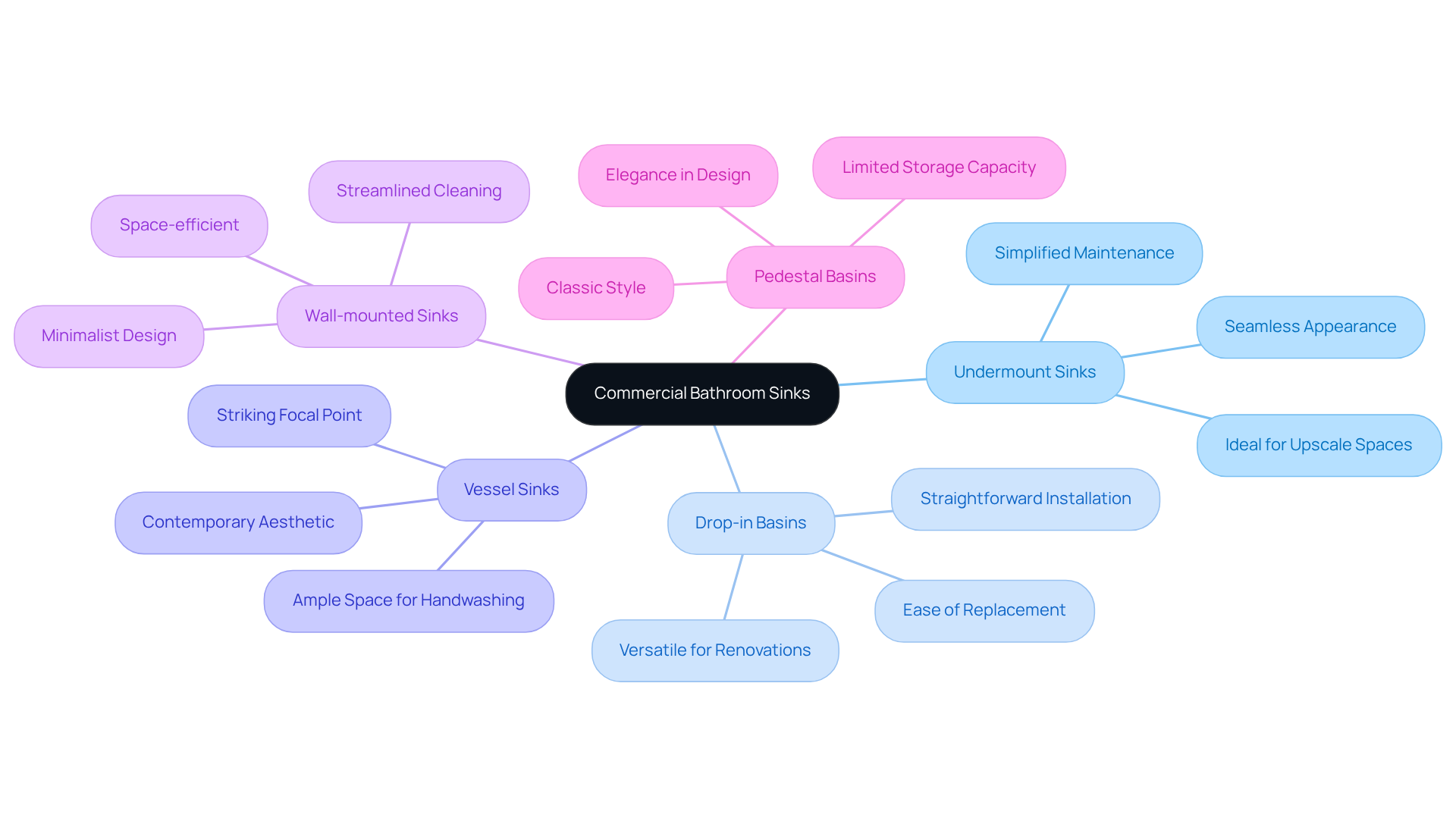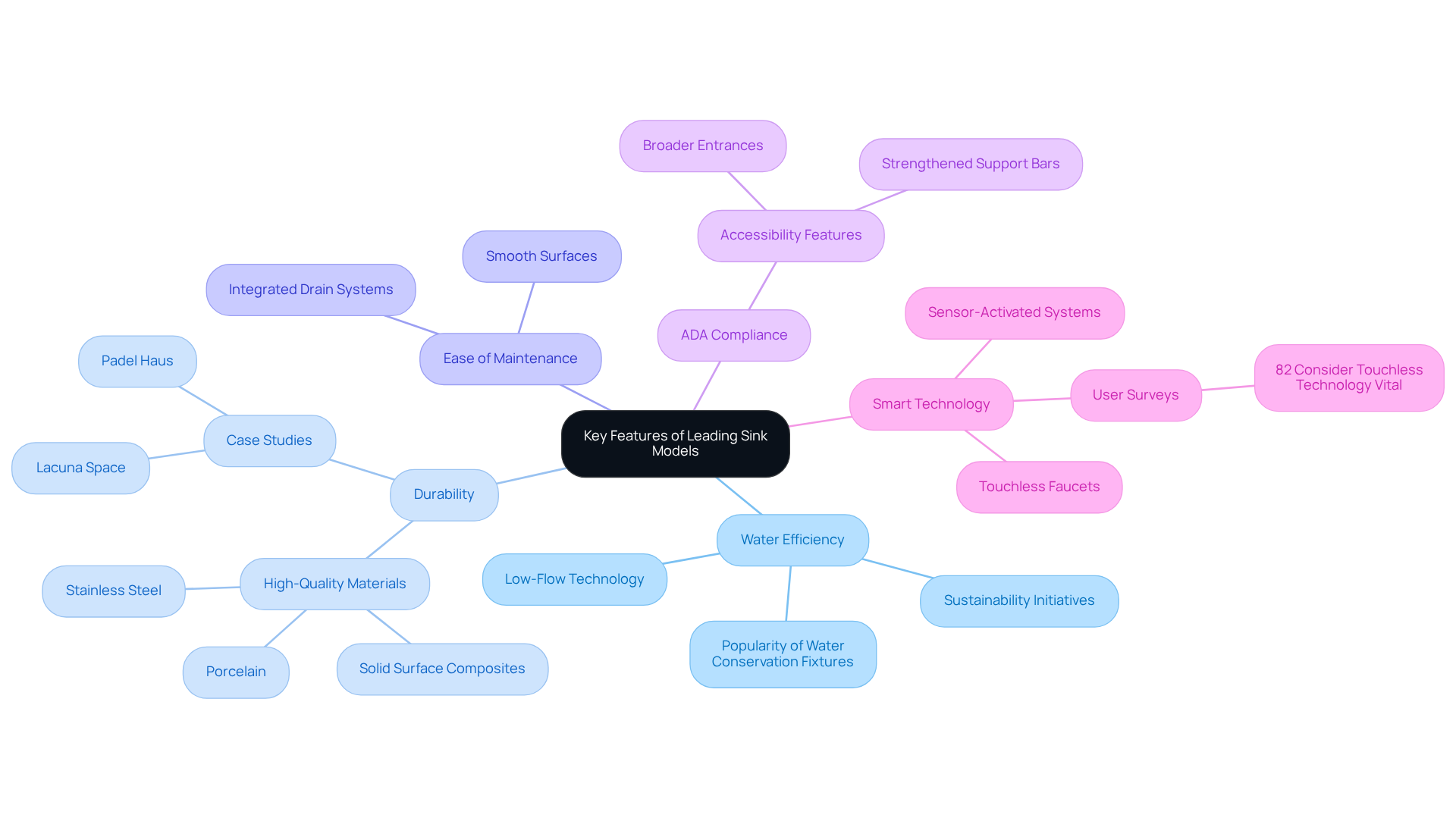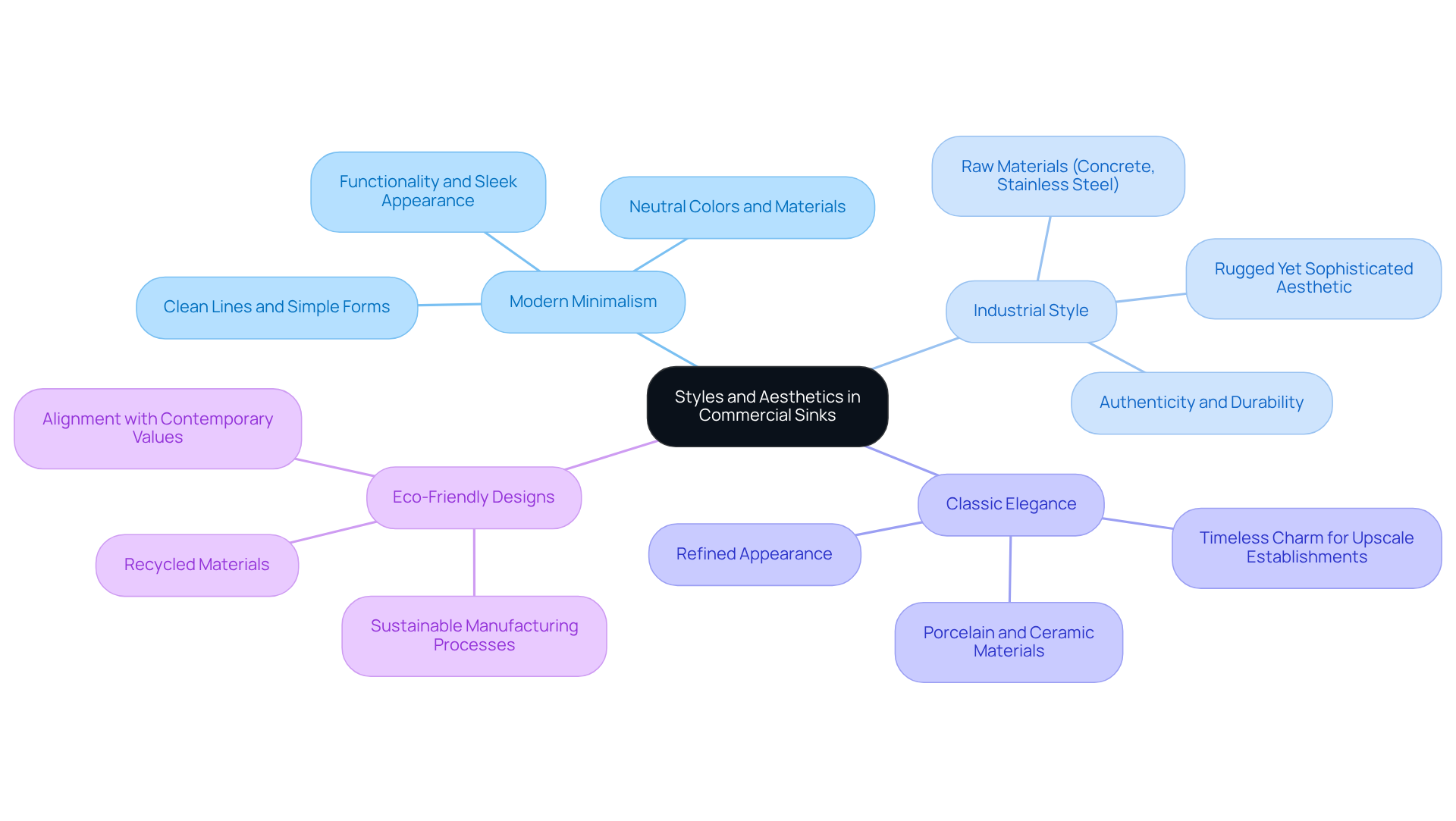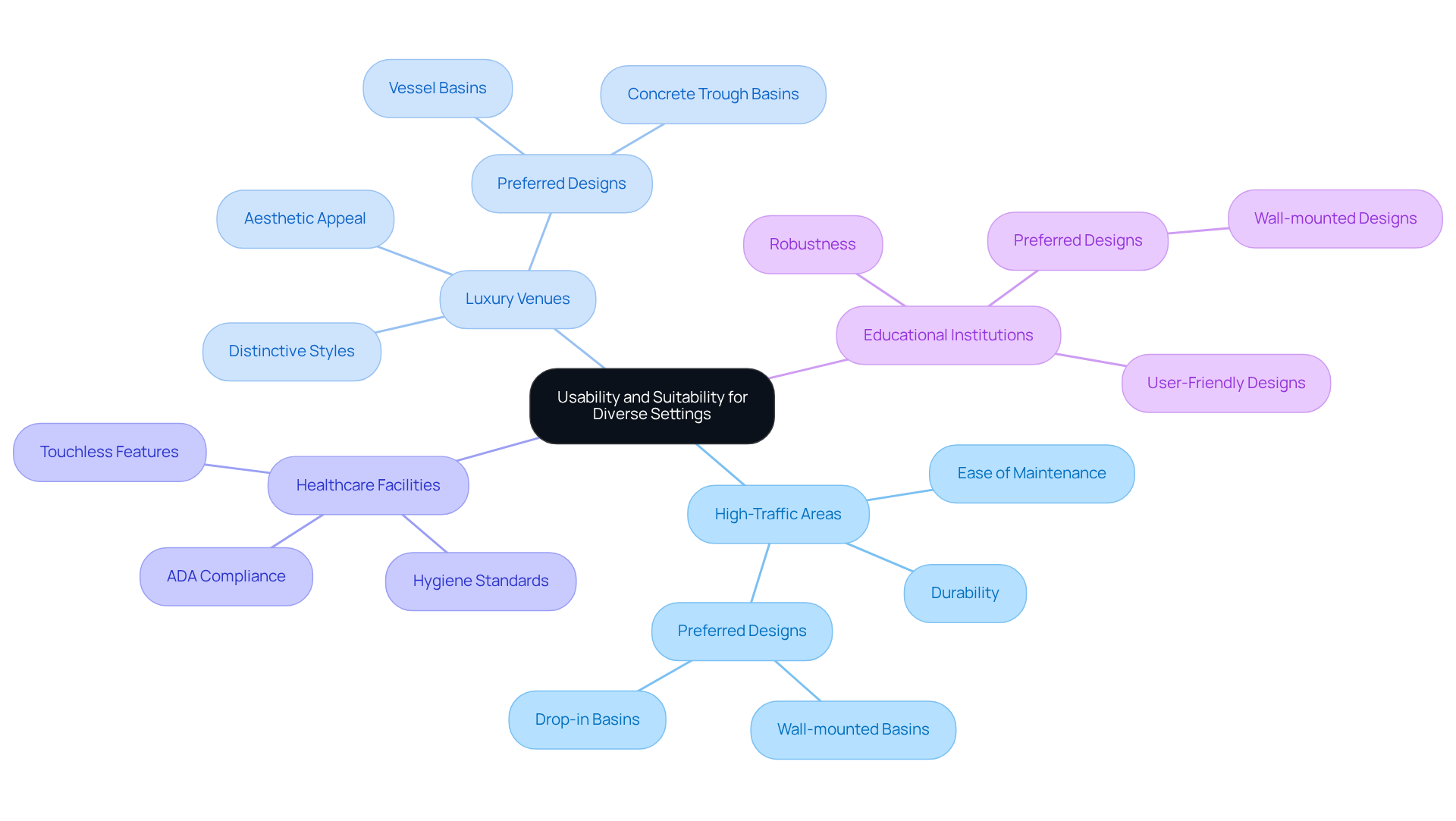Overview
This article delves into the features, styles, and usability of commercial bathroom sinks, underscoring their significance in high-traffic environments. It explores various types of sinks, including:
- Undermount
- Drop-in
- Vessel sinks
while emphasizing their durability, water efficiency, and design compatibility for settings such as luxury venues and healthcare facilities. By illustrating the necessity of selecting the right sink, the article enhances the understanding of how to improve functionality and user experience. Furthermore, the right choice of sink not only elevates the aesthetic appeal but also ensures long-term performance in demanding environments.
Introduction
Commercial bathroom sinks serve as pivotal elements in high-traffic environments, where functionality seamlessly meets aesthetic appeal. With a diverse range of styles and features—from sleek undermount designs to striking vessel sinks—these fixtures adeptly cater to the unique demands of various settings, including luxury venues and bustling public spaces. Furthermore, as trends evolve and sustainability emerges as a priority, how do designers and decision-makers navigate the myriad options available to select the most suitable sinks that balance usability, maintenance, and visual impact?
Overview of Commercial Bathroom Sinks
Commercial bathroom sinks are available in a wide array of styles and materials, each meticulously crafted to meet the demands of high-traffic environments. The most prevalent types include:
- Undermount Sinks: Installed beneath the countertop, these sinks offer a seamless appearance that not only enhances cleanliness but is also ideal for upscale commercial spaces. Their design minimizes visible seams, thereby simplifying maintenance.
- Drop-in Basins: Known for their straightforward installation and ease of replacement, drop-in basins are a favored choice for renovation projects. Their versatility facilitates quick upgrades without the need for extensive remodeling.
- Vessel Sinks: Positioned atop the counter, vessel sinks deliver a contemporary aesthetic, making them highly sought after in boutique hotels and upscale restaurants. They serve as a striking focal point in bathroom layouts while providing ample space for handwashing.
- Wall-mounted Sinks: These space-efficient options are perfect for compact bathrooms, as they free up floor space and streamline cleaning processes. Their minimalist design aligns with modern restroom trends, promoting a sleek and sophisticated look.
- Pedestal Basins: Characterized by their classic style, pedestal basins are frequently found in traditional settings. While they impart elegance, they may lack storage capacity, rendering them less practical for high-traffic areas.
Each type of commercial bathroom sink presents distinct advantages, catering to varying design preferences and practical requirements in commercial facilities. As the market continues to evolve, comprehending these options becomes essential for architects and designers striving to craft effective and visually appealing bathroom environments.

Key Features of Leading Sink Models
Leading commercial bathroom sinks are distinguished by several essential features that cater to modern restroom needs:
- Water Efficiency: Contemporary sinks are engineered to optimize water usage, often incorporating low-flow technology that significantly reduces consumption without compromising performance. This aligns with sustainability initiatives and addresses growing concerns about water scarcity. The increasing popularity of water conservation fixtures further emphasizes this trend.
- Durability: High-quality materials such as stainless steel, porcelain, and solid surface composites are favored for their longevity and resistance to wear, making them ideal for high-traffic environments. Case studies from projects like Padel Haus and Lacuna Space demonstrate that commercial bathroom sinks made of stainless steel maintain their integrity and aesthetic appeal even under heavy use, showcasing their reliability in commercial settings.
- Ease of Maintenance: Smooth surfaces and integrated drain systems are designed for effortless cleaning, which is vital in high-traffic washrooms. These features help maintain hygiene and enhance the overall user experience.
- ADA Compliance: Many sink models are crafted to meet the Americans with Disabilities Act (ADA) standards, ensuring accessibility for all users. Moreover, contemporary bathroom layouts increasingly include elements that exceed ADA standards, such as broader entrances and strengthened support bars, to improve inclusivity.
- Smart Technology: Innovations such as touchless faucets and sensor-activated systems are becoming standard, promoting hygiene and convenience. These technologies not only enhance user experience but also contribute to operational efficiency by reducing the need for frequent maintenance. Significantly, surveys show that 82% of individuals regard touchless technology as vital in bathrooms, emphasizing its importance in contemporary facility layout.
These attributes together improve functionality and contribute to a more enjoyable bathroom experience, reflecting the changing needs of commercial bathroom sinks architecture.

Styles and Aesthetics in Commercial Sinks
The visual appeal of commercial bathroom sinks significantly influences restroom layout, with a variety of styles catering to different settings and customer preferences. Key styles include:
-
Modern Minimalism: Characterized by clean lines and simple forms, modern sinks frequently exhibit neutral colors and materials that effortlessly blend into contemporary spaces. This style prioritizes functionality while upholding a sleek appearance, appealing to those who appreciate understated elegance.
-
Industrial Style: Sinks fashioned from raw materials such as concrete or stainless steel resonate in urban environments, delivering a rugged yet sophisticated aesthetic. This choice reflects a growing trend towards authenticity and durability, making it a favored option for modern commercial spaces.
-
Classic Elegance: Traditional sinks, often crafted from porcelain or ceramic, exude a timeless charm suitable for upscale establishments. Their enduring style ensures they remain relevant, attracting customers who favor a more refined appearance.
-
Eco-Friendly Designs: Sinks made from recycled materials or employing sustainable manufacturing processes cater to environmentally conscious consumers. As sustainability becomes increasingly paramount, these designs not only enhance the bathroom's visual appeal but also align with contemporary values.
The selection of basin design not only influences the restroom's visual attractiveness but also shapes user perceptions and experiences. For instance, case studies from initiatives like Padel Haus in New York illustrate how tailored basin designs can enhance functionality while reflecting the unique character of the locale. Moreover, insights from interior designers underscore the rising preference for industrial-style basins, which merge practicality with a modern flair. As the demand for innovative restroom solutions, particularly commercial bathroom sinks, continues to escalate, grasping these aesthetic trends is crucial for creating environments that resonate with users.

Usability and Suitability for Diverse Settings
The design and specific requirements of their intended environments significantly shape the usability of commercial bathroom sinks.
High-Traffic Areas: In bustling locations such as airports, malls, and stadiums, durability and ease of maintenance are paramount. Wall-mounted and drop-in basins are often preferred for their practicality and streamlined installation, allowing for efficient use of space and resources.
Luxury Venues: Upscale hotels and fine dining establishments typically choose vessel basins or designer models that serve practical purposes while enhancing overall aesthetic appeal. These basins frequently showcase distinctive styles and premium materials, contributing to a lavish experience for visitors. The integration of concrete trough basins in luxury environments is gaining traction, as they provide a striking, monolithic appearance that complements modern interiors, anticipated to be crucial for enhancing bathroom design in 2025. As Brent Otsuka, Manager of Interior Design at Fentress Architects, notes, "The Splash Lab is often the first choice for creating well-designed restrooms," underscoring the importance of selecting high-quality fixtures in these environments.
Healthcare Facilities: In hospitals and clinics, ADA-compliant basins equipped with touchless features are essential to ensure accessibility and maintain high hygiene standards. These creations address the requirements of all users, fostering a secure and clean environment. The demand for hands-free scrub and handwashing basin systems is increasingly valued across various settings, including luxury venues, where hygiene is critical.
Educational Institutions: Sinks in schools must be robust and user-friendly for children, often favoring wall-mounted designs that save space while providing easy access. The emphasis here is on durability and safety, ensuring that the basins can withstand frequent use.
By thoughtfully evaluating the distinct needs of each environment, decision-makers can choose basins that not only enhance functionality but also greatly boost user satisfaction, especially in upscale locations where the customer experience is essential. Furthermore, the emphasis on sustainability and user-friendly functionality in sink design aligns with contemporary trends, making it crucial for decision-makers to consider these factors in their selections.

Conclusion
Commercial bathroom sinks serve as essential elements in crafting both functional and visually appealing restrooms, especially in high-traffic environments. By understanding the diverse types, features, and styles available, architects and designers can make informed choices that address practical needs while enhancing aesthetic appeal.
This article elucidates several key sink types, including:
- Undermount
- Drop-in
- Vessel
- Wall-mounted
- Pedestal basins
Each providing distinct advantages tailored to various settings. Critical features such as:
- Water efficiency
- Durability
- Maintenance ease
- ADA compliance
- Smart technology
Play a pivotal role in elevating user experience and fulfilling the demands of modern facilities. Moreover, the aesthetic trends, spanning from modern minimalism to eco-friendly designs, underscore a growing commitment to sustainability and user-centric design.
In conclusion, selecting the appropriate commercial bathroom sink necessitates a thorough consideration of functionality, style, and the specific requirements of the intended environment. As the market continues to evolve, remaining informed about the latest trends and innovations will ensure that restroom designs not only fulfill operational needs but also foster a welcoming atmosphere for users. Embracing these insights can lead to more effective and visually compelling restroom solutions that align with contemporary values and expectations.
Frequently Asked Questions
What are the main types of commercial bathroom sinks?
The main types of commercial bathroom sinks include undermount sinks, drop-in basins, vessel sinks, wall-mounted sinks, and pedestal basins.
What are undermount sinks, and what are their advantages?
Undermount sinks are installed beneath the countertop, offering a seamless appearance that enhances cleanliness and is ideal for upscale commercial spaces. Their design minimizes visible seams, simplifying maintenance.
Why are drop-in basins popular for renovation projects?
Drop-in basins are favored for their straightforward installation and ease of replacement, allowing for quick upgrades without the need for extensive remodeling.
What is the aesthetic appeal of vessel sinks?
Vessel sinks are positioned atop the counter and deliver a contemporary aesthetic, making them highly sought after in boutique hotels and upscale restaurants. They serve as a striking focal point in bathroom layouts.
What are the benefits of wall-mounted sinks?
Wall-mounted sinks are space-efficient, freeing up floor space and streamlining cleaning processes. Their minimalist design aligns with modern restroom trends, promoting a sleek and sophisticated look.
What characterizes pedestal basins, and where are they commonly found?
Pedestal basins are characterized by their classic style and are frequently found in traditional settings. While they impart elegance, they may lack storage capacity, making them less practical for high-traffic areas.
Why is it important for architects and designers to understand the different types of commercial bathroom sinks?
Understanding the various options for commercial bathroom sinks is essential for architects and designers as they strive to create effective and visually appealing bathroom environments that meet practical requirements.




